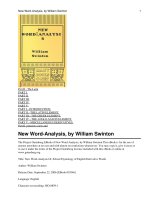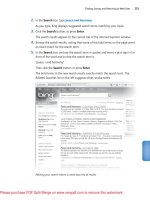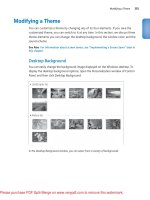Tài liệu Machine Tool & MachiningPrepared By: Hafiz Muhammad Nadeem Sharif B.Sc, M.Sc Mechanical U Waterloo Canada Lecturer MED, U.E.T Lahore doc
Bạn đang xem bản rút gọn của tài liệu. Xem và tải ngay bản đầy đủ của tài liệu tại đây (756.53 KB, 75 trang )
Machine Tool & Machining
Prepared By:
Hafiz Muhammad Nadeem Sharif
B.Sc, M.Sc Mechanical U Waterloo Canada
Lecturer MED, U.E.T Lahore
Copy right reserved
Lathe Machine:
Lathe Machine:
•
A lathe is a machine tool which spins a
block of material to perform various
operations such as cutting, Turning,
Facing, Threading, sanding, knurling,
drilling, or deformation such as
metal spinning with tools that are applied
to the work piece to create an object which
has symmetry about an axis of rotation
Lathe Machine:
Lathe Machine:
•
The term Centre Lathe is derived from the
fact that in its operation the lathe holds a
piece of material between two rigid
supports called centres, or by some other
device such as a chuck or faceplate which
revolves about the centre line of the lathe.
Lathe Machine
Center lathe
LATHE
Major categories of lathes
Major categories of lathes
•
Woodworking lathes
•
Metalworking lathes or universal Engine
Lathes
•
Glassworking lathes
•
Metal spinning lathes
•
Ornamental turning lathes
•
Rotary lathes
•
Turret Lathe
Lathe Operation
TURNING
FACING
Lathe Operation
TAPER TURNING PARTING OFF/ UNDER CUTTING
Radius Turning Attachment
Drilling on a Lathe
Metal Working Lathe / Metal Lathe:
Metal Working Lathe / Metal Lathe:
•
Metal lathe or metalworking lathe are
generic terms for any of a large class of
lathes designed for precisely machining
relatively hard materials.
•
They were originally designed to machine
metals
Working of Metal Lathes:
Working of Metal Lathes:
•
In a metalworking lathe, metal is removed
from the workpiece using a hardened
cutting tool, which is usually fixed to a
solid moveable mounting called the
"toolpost", which is then moved against
the workpiece using handwheels and/or
computer controlled motors
•
Some lathes may be operated under control of a
computer for mass production of parts
•
Metalworking lathes are commonly provided with
a variable ratio gear train to drive the main
leadscrew.
•
This enables different pitches of threads to be
cut.
•
Some older gear trains are changed manually by
using interchangeable gears with various
numbers of teeth, while more modern or
elaborate lathes have a quick change box to
provide commonly used ratios by the operation
of a lever.
Components of Metal Lathe:
Components of Metal Lathe:
•
A metal lathe consists of, at the least, a
headstock, bed, carriage and tailstock.
The better machines are solidly
constructed with broad bearing surfaces
(slides or ways) for stability and
manufactured with great precision.
•
This helps to ensure that the components
manufactured on the machines can meet
the required tolerances and repeatability.
Headstock
Headstock
•
The headstock (H1)
houses the main
spindle (H4), speed
change mechanism
(H2,H3), and change
gears (H10). The
headstock is
required to be made
as robust as possible
due to the cutting
forces involved,
Headstock with legend, numbers and text within the description refer to those in the image
Spindle:
Spindle:
•
The main spindle is generally hollow to
allow long bars to extend through to the
work area; this reduces preparation and
waste of material. The spindle then runs in
precision bearings and is fitted with some
means of attaching work holding devices
such as chucks or faceplates. This end of
the spindle will also have an included
taper, usually morse to allow the insertion
of tapers and centers.
Electric Motor and Gear Box
•
On older machines the spindle was
directly driven by a flat belt pulley with the
lower speeds available by manipulating
the bull gear,
•
Later machines use a gear box driven by
a dedicated electric motor.
•
The fully geared head allows the speed
selection to be done entirely through the
gearbox
Bed
Bed
•
The bed is a robust base that connects to
the headstock and permits the carriage
and tailstock to be aligned parallel with the
axis of the spindle. This is facilitated by
hardened and ground ways which restrain
the carriage and tailstock in a set track.
•
The carriage travels by means of a
rack and pinion system, leadscrew of
accurate pitch, or feedscrew.
Feed and lead screws
Feed and lead screws
The feedscrew (H8) is a long driveshaft that
allows a series of gears to drive the carriage
mechanisms. These gears are located in the
apron of the carriage. Both the feedscrew and
leadscrew (H9) are driven by either the change
gears or an intermediate gearbox known as a
quick change gearbox (H6) or Norton gearbox.
These intermediate gears allow the correct ratio
and direction to be set for cutting threads or
worm gears.
Carriage
Carriage
•
In its simplest form the
carriage holds the
tool bit and moves it
longitudinally (turning) or
perpendicularly (facing)
under the control of the
operator. The operator
moves the carriage
manually via the
handwheel (5a) or
automatically by
engaging the feedscrew
with the carriage feed
mechanism (5c).
Carriage with legend, numbers and text within the description refer to those in
the image
Cross-slide
Cross-slide
•
The cross-slide stands atop the carriage
and has a leadscrew that travels
perpendicular to the main spindle axis, this
permit facing operations to be performed.
This leadscrew can be engaged with the
feedscrew (mentioned previously) to provide
automated movement to the cross-slide; only
one direction can be engaged at a time as an
interlock mechanism will shut out the second
gear train.
Compound rest
Compound rest
•
The compound rest (or top slide) is the
part of the machine where the tool post is
mounted. It provides a smaller amount of
movement along its axis via another
leadscrew. The compound rest axis can
be adjusted independently of the carriage
or cross-slide. It is utilized when turning
tapers, when screwcutting or to obtain
finer feeds than the leadscrew normally
permits.
Tailstock
Tailstock
The tailstock is a
toolholder
directly mounted
on the spindle
axis, opposite
the headstock
Tailstock with legend, numbers and text within the description refer to those in the
image
Lathe videos
Tailstock
Tailstock
•
The spindle (T5) does not
rotate but does travel
longitudinally under the
action of a leadscrew and
handwheel (T1). The
spindle includes a taper to
hold drill bits, centers and
other tooling. The tailstock
can be positioned along
the bed and clamped (T6)
in position as required.
There is also provision to
offset the tailstock (T4)
from the spindles axis, this
is useful for turning small
tapers.
Tailstock with legend, numbers and text within the description refer to those in the
image
CHUCKS
Three-jaw chuck:
Three-jaw chuck:
•
A three-jaw chuck is a
rotating clamp which uses
three dogs or 'jaws', usually
interconnected via a scroll
gear (scroll plate), to hold
onto a tool or work piece.
Three-jaw chucks are
usually self-centering (as a
result of the jaws' meshing
with the scroll plate) and
are best suited to grip
circular or hexagonal cross
sections when very fast,
reasonably accurate
centering is desired
Self centering three-jaw chuck and key
Work holding device videos









